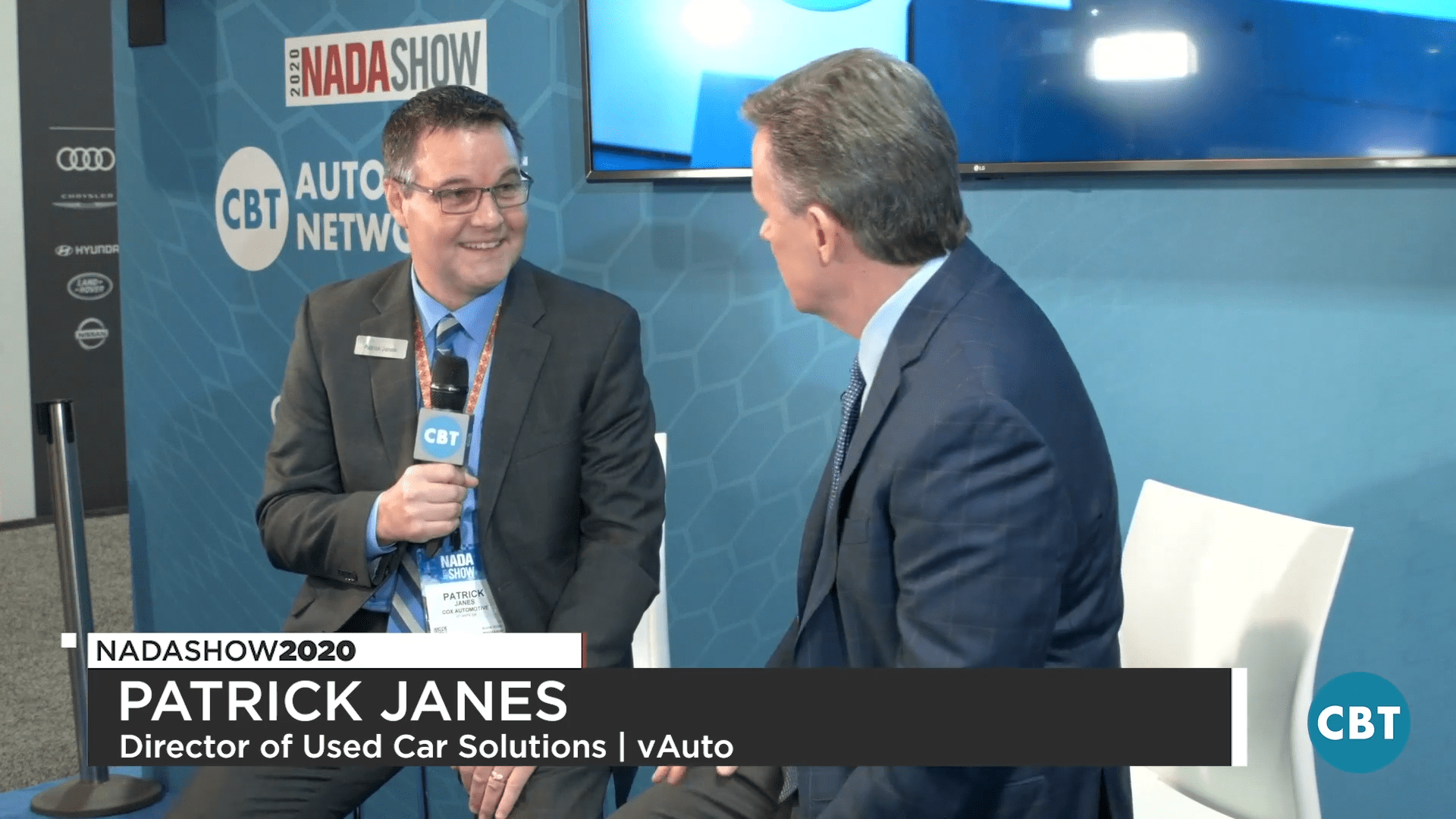At NADA 2020 in sunny Las Vegas, host Jim Fitzpatrick was joined by Patrick Janes, Director for used-car solutions at vAuto.
Jim Fitzpatrick: Dealers are looking for used-car solutions, aren’t they?
Patrick Janes: This year they are, that’s for sure. It’s an exciting time to be in the used-car business.
Jim Fitzpatrick: There’s no question about it. From Cox Automotive, we spoke to Jonathan Smoke not too long ago in the studio. He said the SAAR for new car will be probably around $16,600-ish for 2020. However, used cars will be on the increase, right?
Patrick Janes: Exactly. About 300,000 down on the new car side, but used-car retail sales up 300,000.
Jim Fitzpatrick: That’s a beautiful thing.
Patrick Janes: Interesting dilemma.
Jim Fitzpatrick: That’s right.
Patrick Janes: But an opportunity.
Jim Fitzpatrick: We see where the buyers are going, aren’t we?
Patrick Janes: Yeah.
Jim Fitzpatrick: For sure. And also that’s where the money is, in used cars. Let’s talk a little bit about that. For the audience, what’s going on in the used-car world at NADA for 2020?
Patrick Janes: We see that opportunity coming with that 300,000 lift.
Jim Fitzpatrick: Right.
Patrick Janes: But with the new cars going down, that could be maybe not as many trades out there as there was in the past.
Jim Fitzpatrick: Oh, that’s true. I didn’t think about that.
Patrick Janes: For someone like me who gets to manage a software solution that helps you find wholesale units, that’s a real opportunity for us as well. And we think dealers can use better data to put an acquisition strategy together because they got to feed that machine to take advantage.
Jim Fitzpatrick: That’s right. I didn’t even think about the down in used cars, that’s for sure, the trade-ins. How can dealers best take advantage of that potential in the used-car market?
Patrick Janes: For me, in my retail career, I was a medium-size dealer in a rural market. And we have a lot of dealers on vAuto that do that. And if you came to me and said, “Hey, you need big data to be able to make these better decisions, I’d have said, “Hey, the mega-dealers got that departments to crunch all that stuff, they give me insights.” I need actionable data, right?
Jim Fitzpatrick: That’s right.
Patrick Janes: What we’re trying to do is to provide actionable data to the dealer. We spent the past year at vAuto through our Stockwave, our first of its kind, wholesale management solution. We have used that and we’ve introduced metrics like Dale Pollak’s profit times scoring, all the way to our live market view for dealers that don’t even have provision inventory management.
Jim Fitzpatrick: Wow.
Patrick Janes: So we think that these insights are going to be able to allow them to most importantly find the cars, but more importantly is to actually find cars that will sell in their market and be profitable, which is tricky when you’re in the auction space, right?
Jim Fitzpatrick: Wow, you got a software technology for that. I mean that is like building a better mousetrap for dealers, without a doubt.
Patrick Janes: They can see hundreds of thousands of cars right across all auctions. They can simply click a light bulb, does an instant appraisal to be able to give them all the data points, but it’s local market data. I could be looking at a black interior, black vehicle in Florida. I’m up in Washington, D.C. where that car is not very popular in Florida in July, but in Washington, D.C.-
Jim Fitzpatrick: And it’s a convertible.
Patrick Janes: … I can sell that car all day long.
Jim Fitzpatrick: Yeah, sure. That’s right.
Patrick Janes: It doesn’t matter. I can maybe buy that car for less money, move it up to D.C., and take advantage of the market.
Jim Fitzpatrick: That’s right. All with the click of a mouse.
Patrick Janes: Yes.
Jim Fitzpatrick: Wow, that’s incredible. Data and big data have been the buzz words for years. How is vAuto Stockwave in particular applying the data? It just kind of more of what you just talked about?
Patrick Janes: Yeah, it’s really just taking that data and putting it into a set of metrics. Historically, us used-car guys use guidebooks, right?
Jim Fitzpatrick: Right, right.
Patrick Janes: Black Book, NADA, whatever, historical data looking through the rear view mirror, if you will.
Jim Fitzpatrick: Exactly.
Patrick Janes: So we’re trying to give them data in a tool that tells them what’s going on when I put that car on the internet today. Through our live market view, through Dale’s profit scoring system, through all these different metrics that our dealers that use provision inventory management, they know the metrics, we’re just bringing it to them real fast, because let’s face it, going to the auction, standing in the lane with your hand up is a very time-consuming process.
Jim Fitzpatrick: That’s right.
Patrick Janes: We’re trying to give them that data in the comfort of their office.
Jim Fitzpatrick: Wow.
Patrick Janes: To be able to do all that presale work.
Jim Fitzpatrick: Fantastic.
Patrick Janes: If you still think you need to go to the auction, knock yourself out, but with all the online buying that’s going on today, I can buy cars on a regular basis at my dealership, and still carry on merchandising and all the things that I need to be doing, because I’m wearing a lot of hats as a used-car manager now.
Jim Fitzpatrick: That’s right. In fact, maybe more hats because dealerships are cutting back in headcount, so they’re like, “I don’t know if we need assistants after assistants, you do it.”
Patrick Janes: They got to fill those holes. In our opinion, you fill it with technology. It’s like anything else. Look at the manufacturing industry. They got robots that did things that people used to do. Technology’s filling that gap. I’m not saying we can do away with human intervention. There’s still a skill set to be able to look at that vehicle and make sure it fits my strategy and then-
Jim Fitzpatrick: And make sure the car is what it is when it arrives at the lot.
Patrick Janes: Exactly. What we’re trying to do is get guys off of airplanes. Like back in the day we used to fly to across the country to different auctions.
Jim Fitzpatrick: That’s right.
Patrick Janes: You can still cast a wider net and find cars, end up different auctions, but ship them to me. With insurance products now if the car doesn’t work, most auctions, insurance products will take it back, so it’s less risk.
Jim Fitzpatrick: Back in the day, if I would fly to an auction, I always felt this obligation to come back with cars, even though in the back of my mind I’m going, “Okay, I don’t know that that’s necessarily the best car for my lot right now, but I can’t go back to the GM and say, “I didn’t buy anything.” I’m two days on the road, and it costs you a hotel and airfare and everything else, and I didn’t get anything. They’re like, “You got to be kidding me.” But I knew in my heart of hearts, these cars aren’t necessarily tens, they might be like sixes, because I had to bring something back.
Patrick Janes: Think about the inefficiency you just created. So you bought two loads of cars that come back to your dealership. Customer pays on fire, right. The service guy’s going, “Oh, I’ll get to them when I get to them,” because I got to take care of the customers first.
Jim Fitzpatrick: That’s right.
Patrick Janes: Now I’ve got a log jam. I can’t get the vehicles through the system onto the market.
Jim Fitzpatrick: They all age at the same time.
Patrick Janes: Exactly. We’re trying to get dealers and we work with them. Our performance consultants work with them. We want dealers to buy daily.
Jim Fitzpatrick: Right.
Patrick Janes: It’s like feeding the system just in time so that they don’t have to carry that excess stock or carry that dead stock that’s really not for sale until you get it through recon and get photos and get it up online.
Jim Fitzpatrick: Then you don’t want to wake up one day and go, “Oh great, I just had 25 cars turned 60 days today.” You know what I mean?
Patrick Janes: Exactly.
Jim Fitzpatrick: Because you’re not going to sell 25 cars in one… for the most part. I mean there’s some dealerships that do, but you’re not going to sell the 25 60 day-old units. You know what I mean?
Patrick Janes: Dale in his book has been talking about, keep that inventory low, keep a 30 days worth of inventory. Some people go, “Oh my gosh, we always get 60 days worth of inventory and sell 30, how do you even do that?”
Jim Fitzpatrick: That’s right.
Patrick Janes: Well, if you’re using technology, you’re filling those holes in inventory on a daily basis.
Jim Fitzpatrick: Replenishing, that’s right.
Patrick Janes: That stuff’s coming in on a daily basis. It can be done. I’m not going to lie, it takes some work, but the technology helps you to do that, instead of the old days where you just went to auction and just bought what you could and then went back three weeks later and bought another couple loads.
Jim Fitzpatrick: That’s right, or you’re bringing those cars that you bought back to auction because they didn’t sell and the dealer goes, “Look, they all turned 75 days, get them out of here. Go, take them…”
Jim Fitzpatrick: What’s the number one piece of advice that you’d have for dealers here at NADA? I’m sure that from your perspective, you work with dealers all over the country in the used-car and helping them navigate that. What are your words of wisdom? What’s your advice for 2020?
Patrick Janes: I can’t get it down to one thing, but there’s two part… If there’s one word it would be acquisition strategy. What is your strategy? So we want dealers to think not like a speculator, “Ooh, 300,000 more units. I can grow my business, I need to offset this maybe downturn in the new car market, but to really take an investor strategy. I want to look at every vehicle that I am going to bring in and look, make sure it stands on its own and make sure I can turn that vehicle when it comes in, and make sure it’s profitable. But to do that, I think you got to look at two things. One is you got to look at your, what we call look-to-book in vAuto, your trade capture. Make sure that your look-to-book or your trade appraisal process is rock solid. Measuring your appraisers all the way down to your salespeople, making sure you’re using third-party data like Kelly Blue Book. Just be transparent to the customer and sell that trade value.
Patrick Janes: Once you feel like you’re getting every trade that you can, you’re at a 50, 60% trade capture rate, then you got to go fill the inventory, right?
Jim Fitzpatrick: Right.
Patrick Janes: So I think the average franchise dealer or NADA says gets about 26% of their cars at auction.
Jim Fitzpatrick: Okay.
Patrick Janes: I think there’s a lot of dealers that aren’t doing that because they’ve been trying to stay out of the auction because new car business has been good. The trades have been coming in. They got to go back to the auction now.
Jim Fitzpatrick: That’s right.
Patrick Janes: To do that though, use data and metrics to be able to analyze each and every unit, instead of just saying, “Hey, we’ve been doing great with this particular car.” The GSM says, “Go buy me 10 of those.” Really take a strategic approach to fill those holes so that you can keep that machine running.
Jim Fitzpatrick: That’s right. Patrick Janes, director of used-car solutions at vAuto. I want to thank you so much for taking the time out of your busy schedule. Your booth is on fire over there, so I’m sure you got to go back and wrap up some deals.
Patrick Janes: Yeah, my voice will be gone here another five hours.
Jim Fitzpatrick: That’s right. Thanks so much.









